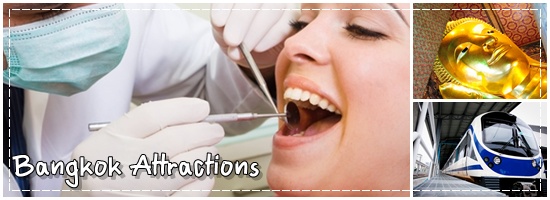
The Grand Palace
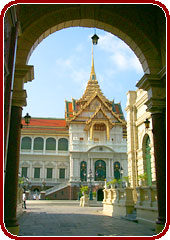
When King Rama I ascended the throne in 1782, he decided to move the capital city from the area on the west bank of the Chao Phraya River, where the former Thonburi Palace was located, to the Eastern side of the river. The construction work lasted for three years. The Grand Palace was built then, with a temple or Royal Chapel located within the compound of the palace.
The architectural plan of the new Grand Palace is almost identical in every detail to that of the Royal Palace in the former capital of Ayutthaya. It was built close to the river facing north with the river on the left. This palace has an area of 218,400 sq. metres and is surrounded by walls built in 1782. The length of the four walls is 1,900 metres. Within these walls are situated government offices and the Chapel Royal of the Emerald Buddha besides the royal residences.
Rama I moved the centre of administration to this side of the Chao Phraya and, after erecting public monuments such as fortifications and monasteries. The King ordered the palace to be built not only as his residence but also as his offices--the various ministries, only one of which remains in the palace walls. This palace came to be known as the Grand Palace, in which the earliest edifices contemporary with the foundation of Bangkok were the two groups of residences named the Dusit Maha Prasat and the Phra Maha Monthian.
The palace is divided into three sections:
- The Outer Palace (Phra Ratchathan Chan Nok) on the north
- The Middle Palace (Phra Ratchathan Chan Klang) at the east
- The Inner Palace (Phra Ratchathan Chan Nai) to the west
THE OUTER PALACE
This section consists of two parts, the Royal Temple (Wat Phra Kaeo) to the east and the administrative offices to the west.
Wat Phra Kaeo was built in 1782 on the orders of King Rama I along with the Grand Palace and Ratanakosin Island. It is a royal temple built within the Grand Palace compound therefore there is no resident monks. The temple is a treasure house of Thai arts, and houses the Emerald Buddha, the most revered Buddha image in Thailand.
THE MIDDLE PALACE
The principle palace buildings are located in this area. They are classified into three groups -- The Dusit Group, The Phra Maha Monthain Group and The Chakri Group.
THE DUSIT GROUP (Phra Thinang Dusit Maha Prasat)
Here we have an audience hall with a throne of mother-of-pearl surmounted by the usual nine-tiered white canopy, the mark of a duly crowned king. At the back of this audience hall is yet a living quarter. All are built in pure Siamese architecture of perfect proportions. In front of this group is the Disrobing Pavilion--Arporn Phimok-- which was reproduced and sent to adorn the Thailand exhibits at the Exhibition of Brussels in 1958.
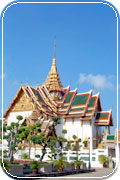 Dusit Maha Prasat Throne Hall is the first throne hall built with in the Grand Palace. King Rama I built this hall as a replacement for an earlier wooden Phra Thinang Amarintharapisek Maha Prasat which burned down in 1790. King Rama I intended that the present building be used for his own Lying-in-State as it has the same height and dimensions as the Phra Thinang Suriyamarin at Ayutthaya, the customary hall for the Lying-in-State of Ayutthaya kings. Dusit Maha Prasat Throne Hall is the first throne hall built with in the Grand Palace. King Rama I built this hall as a replacement for an earlier wooden Phra Thinang Amarintharapisek Maha Prasat which burned down in 1790. King Rama I intended that the present building be used for his own Lying-in-State as it has the same height and dimensions as the Phra Thinang Suriyamarin at Ayutthaya, the customary hall for the Lying-in-State of Ayutthaya kings.
Thus the principle function of the Dusit Maha Prasat has been and still is a Hall for Lying-in-State of kings, queens and honoured members of the royal family. This Hall is also used for the annual Consecration Day Ceremony (Phra Ratcha Phithi Chat Mongkhon). It houses many important objects.
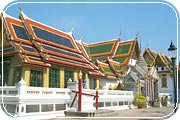 THE PHRA MAHA MONTHIAN GROUP THE PHRA MAHA MONTHIAN GROUP
This group consists of three connecting buildings. They are, from inside out, Chakrapat Phiman (The State Bedchamber), Phaisal Taksin (for the consecration ceremony of the King) and Amarin Winitchai (for foreigner ambassadors' reception)
Outer chamber, the Audience Hall of Amarin Winitchai, where ceremonies of the Court usually take place in front of the throne surmounted by its canopy of nine tiers of white cloth and backed by a boat shaped altar. Originally this was the Principal Audience Hall of the Middle Palace in which officials of state and foreign ambassadors were received in audience. Today it has the same functions as before with the exception that ambassadors no longer present their credentials here.
The middle chamber, Paisal Taksin Hall where the coronation of a monarch takes place with its coronation chair and the octagonal seat where the monarch receives the people's invitation to rule and in the centre between the seats an altar containing the symbolised figure of Siam, by the name of "Phra Syam Thewathirat" or shortly "Phra Syam" traditionally invoked for the good weal of the state.
Descending from here we come to the antechamber to the Chakrapat Phiman building which was the residence of King Rama I, Rama II and Rama III. It has subsequently become customary for the soverign to past at least one night there after the coronation to signify his taking up official residence.
THE CHAKRI GROUP (Phra Thinang Chakri Maha Prasat)
Subsequent Chakri Kings built Thai and European-styles palaces until the complex assumed it present form. Continued with the Grand Palace grounds is much of Thailand's most gorgeous, architecture. A prime example is the Chakri Maha Prasat Throne Hall, built by King Rama V in 1876. The original design by the British architect, Mr John Clunish, called for three European style domes over the building. But at the request of the former regent, Somdej Chao Phraya Borom Maha Si Suriyawong, King Rama V had them changed to prasat spires.
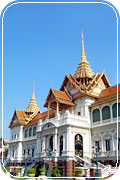 Phra Thinang Chakri Maha Prasat has three stories built on the plan of the letter T. The principal suites, used as reception rooms, occupy the first floor of the East and West Wings. The room below the central Prasat roof on the second floor is used as a shrine for the reliquary ashes of Kings Rama IV and V and their principal queens, as well as those of Kings Rama VI, VII and his queen and Rama VIII. Phra Thinang Chakri Maha Prasat has three stories built on the plan of the letter T. The principal suites, used as reception rooms, occupy the first floor of the East and West Wings. The room below the central Prasat roof on the second floor is used as a shrine for the reliquary ashes of Kings Rama IV and V and their principal queens, as well as those of Kings Rama VI, VII and his queen and Rama VIII.
The reliquary ashes of the first three kings and their queens are enshrined in the Reliquary Hall of the Phra Maha Monthian. The two rooms below the prasat roof on the East and West Wings are respectively used as Repositories for Objects of Veneration and reliquary ashes of lesser queens and members of the royal family. These three rooms are connected by a long corridor.
THE INNER PALACE
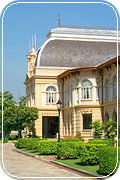 BOROM PHIMAN MANSION (Phra Thinang Borom Phiman) BOROM PHIMAN MANSION (Phra Thinang Borom Phiman)

Built in the western style in 1903 by King Rama V for the Heir Apparent, the future King Rama VI, this mansion was also used at various times as a royal residence by King Rama VII (1925-1935), King Rama VIII (1935-1946), and the present King Rama IX. At present the Borom Phiman Mansion serves as the Royal Guest House for visiting Heads of State and guests of Their Majesties.
Besides King Rama VI, his three successors on the throne have resided here at one time or another. To the north it commands the beautiful view of The Chapel Royal of The Emerald Buddha. To the south the tastefully proportioned Chapel of the Crystal Buddha, a gem afloat on waves of green lawns, and to the west the equally tasteful gabled pavilion, by the name of Mahisorn Prasat built by King Rama IV to enshrine the relics of his august father, King Rama II.
Beyond these buildings lies the Sutthai Sawan Pavilion on the palace wall formerly used now and then for ceremonies during hot weather and the Sivalai Maha Prasat Hall formerly housing the statues of His Majesty's august predecessors since removed to the precincts of The Chapel Royal of The Emerald Buddha.
|